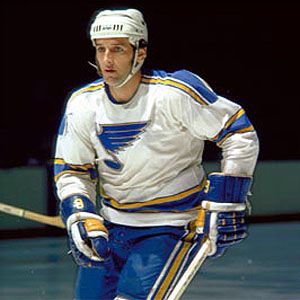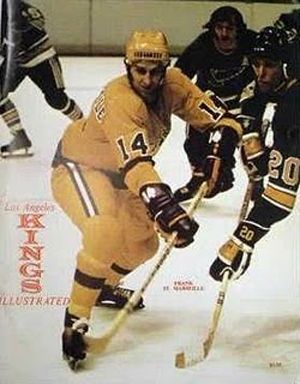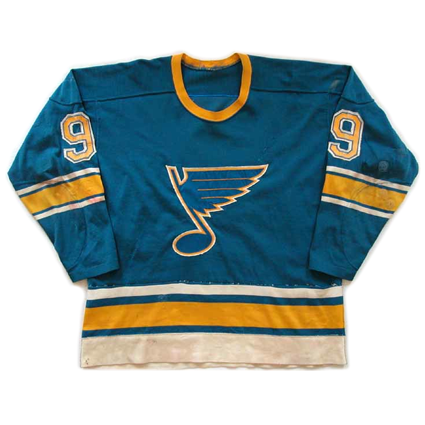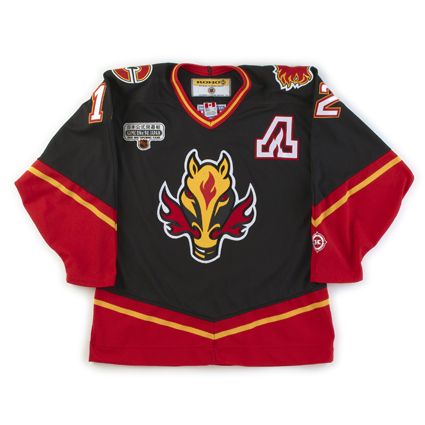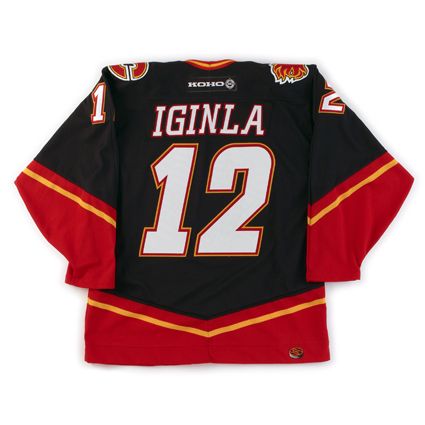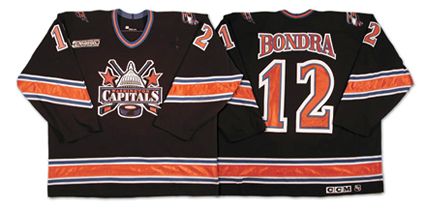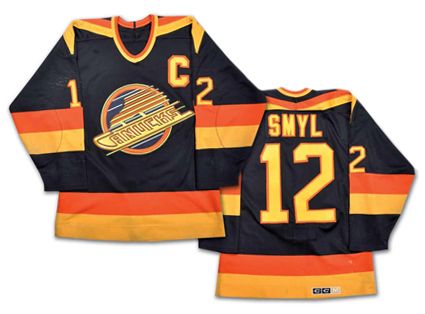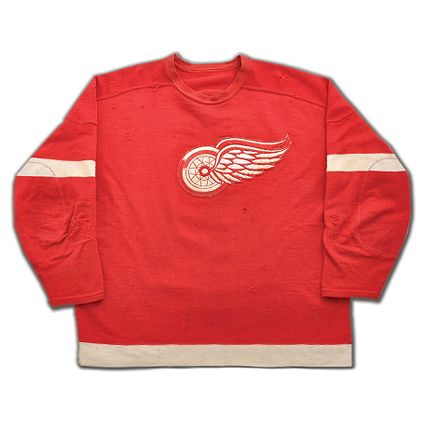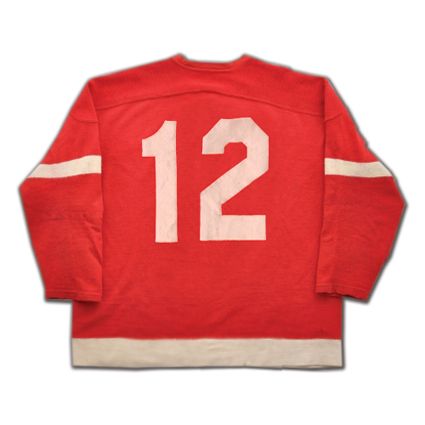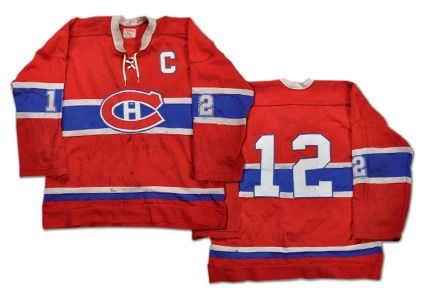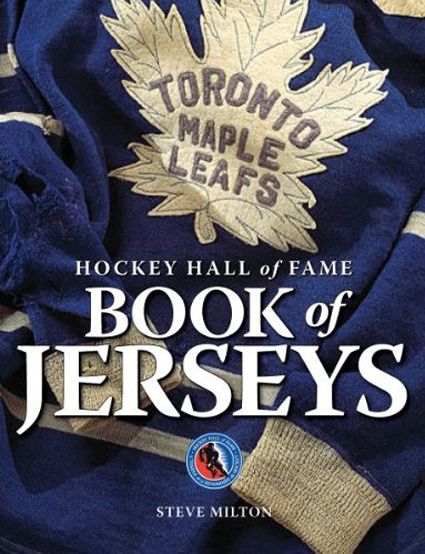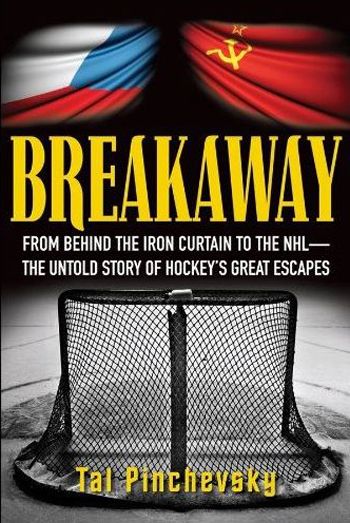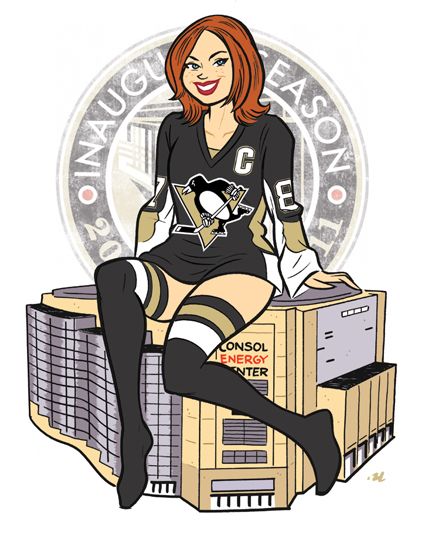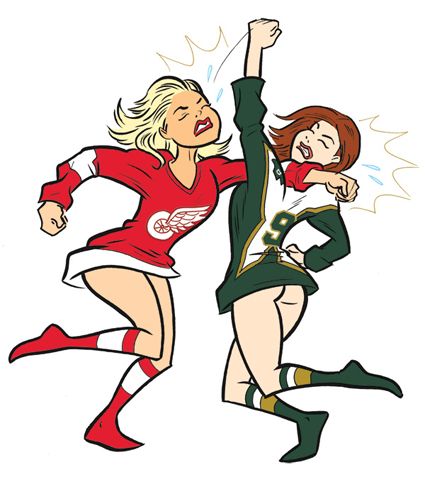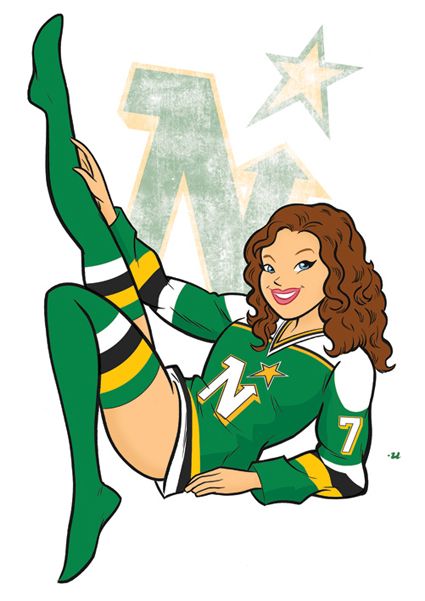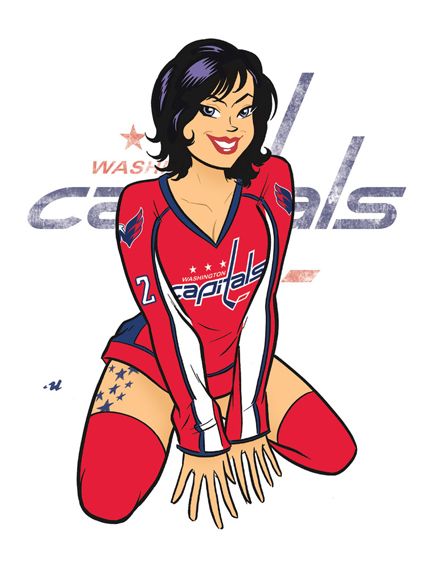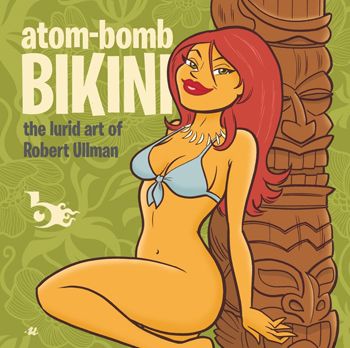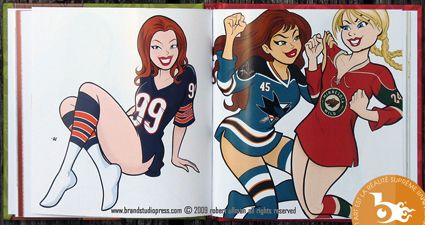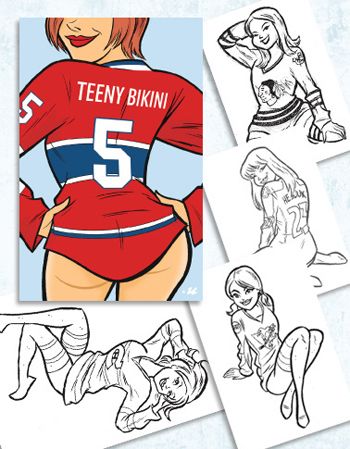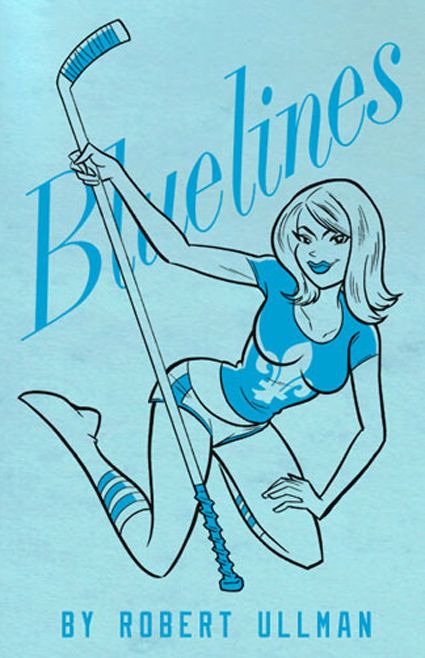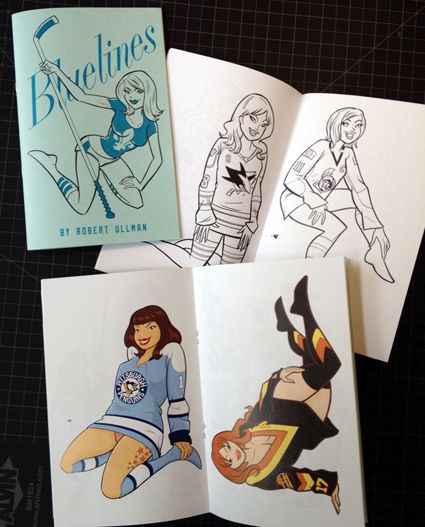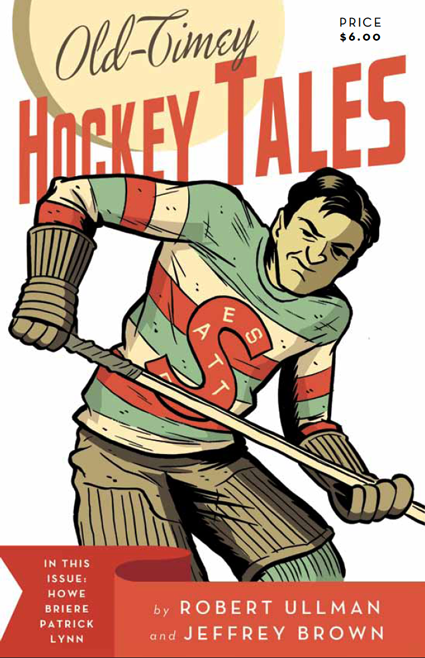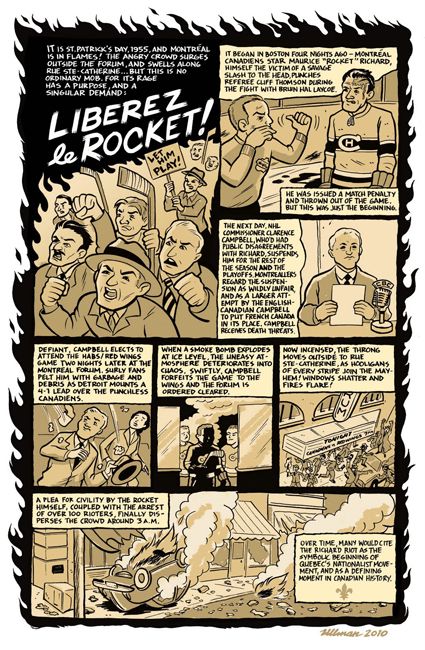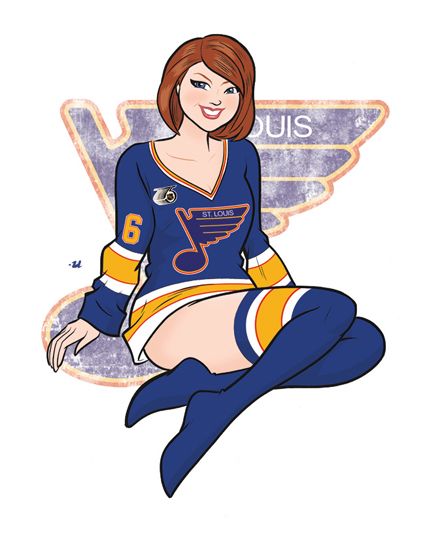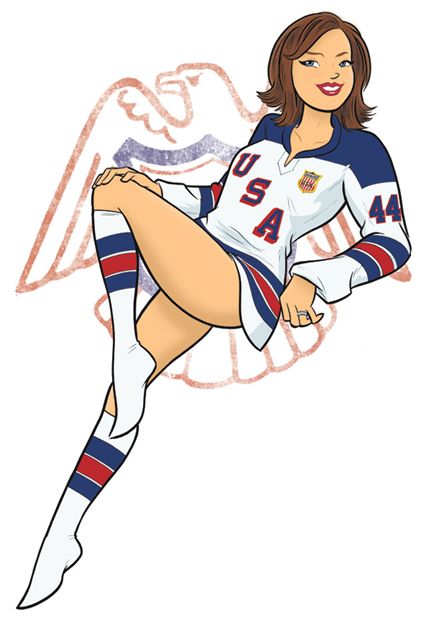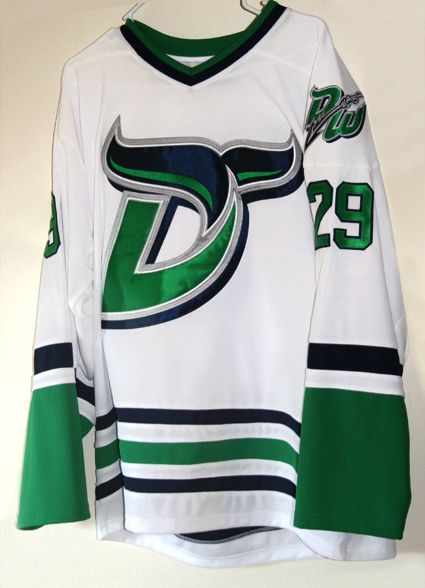Friday, December 14, 2012
1970-71 St. Louis Blues Frank St. Marseille Jersey
Considered too slow for the NHL, Frank St. Marseille, born on this date in 1939, was left undrafted by any club in the six team NHL. He played in the International Hockey League with first the Chatham Maroons om 1963-64, scoring 31 goals, before moving to the Port Huron Flags in 1964. There, St. Marseille lit up the league with his offensive game, scoring 38 goals and 97 points in 70 games in his first season in Port Huron.
He backed that up with a 45 goal, 90 point season the following year and in the postseason he contributed six goals and 12 points in nine playoff games as part of Port Huron's balanced scoring attack (eight members of the Flags had between 11 and 13 points) on their way to the 1966 Turner Cup championship.
St. Marseille, #12 on the Third String Goalie list of the Top Twenty Names in Hockey History, then led the Flags in scoring in 1966-67 on the strength of 41 goals and 77 assists for 118 points, which was good for third overall in IHL scoring. His timing could not have been better, as the NHL was about to expand by six teams for the following season, creating approximately 140 new jobs for players previously unable to crack the lineup of one of the Original 6 clubs.
Prior to his outstanding season, St. Marseille was on the radar of the St. Louis Blues general manager Lynn Patrick, who had been sent a letter by St. Marseille's brother Frederick, who was a singer in Los Angeles when Patrick was managing the Los Angeles Blades of the WHL two years earlier, extolling the virtues of Frank.
When Patrick was working on assembling the original Blues roster in 1967, he sent future Hall of Famer Scotty Bowman to scout St. Marseille, who dubbed him "the Gordie Howe of the IHL" and they invited him to the inaugural Blues training camp. Although he impressed at camp, Patrick and Bowman were still skeptical, declaring "he can't be as good as he seems to be", so St. Marseille was assigned to the Kansas City Blues of the CHL, where he proved he was the real deal, scoring seven goals and 15 points in 11 games, which earned him a call up to St. Louis on November 23, 1967 at the age of 28.
He scored 16 goals and 32 points the rest of the season and contributed 13 more points in 18 playoff games as he experienced the thrill of playing in the Stanley Cup Finals in his first season in the NHL.
After a 38 point season the next year, as well as another run to the cup finals, St. Marseille set a career high with 59 points in 1969-70 and a third straight appearance in the finals.
After two more 50 point seasons with the Blues, St. Marseille was traded to the Los Angeles Kings during the 1972-73 season. His first two seasons in Los Angeles resulted in another pair of 50 point seasons, including his best while in Los Angeles of 53 points in 1974-75.
St. Marseille, now 37 years old, saw a drop off in production in his final two NHL seasons, with 26 then 28 points. He played one additional season with the Nova Scotia Voyageurs of the AHL before retiring as a player to become the Voyageurs coach.
His finals NHL totals in 19 NHL seasons were 140 goals and 285 assists for 425 points in 707 games.
Today's featured jersey is a 1970-71 St. Louis Blues Frank St. Marseille jersey. This was the original Blues style first worn in 1967 and remained unchanged until 1973. Following it's use by the Blues, the jerseys from that season were given to a local St. Louis high school and shortened in length by a couple of inches.
Bonus Jersey: Today's bonus jersey is a 1972-73 Los Angeles Kings Frank St. Marseille jersey. Similar to the Blues jersey pictured above, this Kings jersey was recycled by the club for it's own use. St. Marseille's name was removed from this jersey and it was then either used in the following year's preseason games or sent down to the Kings minor league affiliate in Springfield, Massachusetts, who had adopted the Kings name and colors.
Labels:
St. Louis Blues,
St. Marseille
Wednesday, December 12, 2012
12/12/12
This being 12/12/12 we at Third String Goalie are taking a look at the best players to have ever worn the #12.
Notable players to have worn #12 include Wayne Cashman, Gary Dornhoefer, Simon Gagne, Bill Guerin, Tim Kerr, Tom Lysiak, Don Maloney, Patrick Marleau, Adam Oates, Pat Stapleton, Ron Stewart and Johnny Upton.
One active player we anticipate will have his number retired is the Calgary Flames Jarome Iginla, who has played every one of his 16 NHL seasons with the Flames. Iginla was the Art Ross Trophy winner in 2002 as the NHL's leading scorer and is a member of the 500 goal club, having won the Rocket Richard Trophy as the league's leading goal scorer twice, in 2002 (52) and 2004 (41) as well as another 50 goal season in 2008. He also was named the winner of the Lester Pearson Award in 2002, given to the most outstanding player as voted by the players association. Iginla has been the Flames captain since the 2003-04 season and has also won the King Clancy Trophy for leadership qualities on and off the ice and making a significant contribution to his community.
Iginla's featured jersey is a 1998-99 Calgary Flames Jarome Iginla jersey as worn in Tokyo, Japan during the Flames game on October 10, 1998 against the San Jose Sharks, commemorated with the Game ONe 98 Japan patch on the upper right chest. This game was the debut of the Flames new black alternate jerseys with the horse head logo, worn in recognition of the famous Calgary Stampede rodeo.
One of our favorite features of the jersey is the use of the old Atlanta Flames logo as the alternate captain's "A", in recognition of the franchise's origins in Atlanta.
While we are confident the Flames will retire Iginla's number #12 someday, we wonder why the Washington Capitals have yet to retire Peter Bondra's #12?
Bondra is the Capitals franchise leader in goals with 472, ranks sixth in assists with 353 and remains their all-time leading scorer with 825 points. He also still holds nine team scoring records, including power play, shorthanded and game-winning goals in both a single season as well as in a career.
He played for the Capitals for 14 seasons, third most in franchise history, and led them in scoring for five of those seasons. His goals, points and years of service are greater than all four of the players who have had their jerseys retired by the Capitals, and honoring him is now overdue, something which needs to be corrected.
Bondra's featured jersey is a 1998-99 Washington Capitals Peter Bondra jersey. The Capitals comprehensively rebranded themselves in 1995 when they introduced an entirely new color scheme and logo, replacing their original red, white and blue colors with blue, bronze and black. Two seasons later they debuted a new third jersey, which promoted their secondary logo to the front of their new black jersey. Note the arched treatment for the name on the back, which also employed a single white outline to encapsulate the entire name.
1999-00 was the final season of use as an alternate, notable for the NHL 2000 patch worn by all the players that season. For the 2000-01 season, this jersey replaced The Capitals blue road jersey with the black jersey, which saw the names on the back become straight across and each letter now separate from the others.
Of the four players to have had the number 12 retired in their honor in the NHL, Stan Smyl of the Vancouver Canucks was the first when the Canucks raised his jersey to the rafters on November 3, 1991, the first number retired in Canucks history. After winning two Memorial Cups with the Westminster Bruins in 1977 and 1978, including being named the MVP in 1978, Smyl was drafted by the Canucks in 1978.
While with the Canucks he would become the franchise's leading goal scorer while scoring 60 or more points for seven straight seasons and 20 or more goals for eight straight. He captained the Canucks for eight seasons and would close out his career as the Canucks leader in goals (262), assists (411), points (673) and games (896). While his offensive numbers would decrease dramatically near the end of his career, he was still a valuable player thanks to his defensive skills and relentless checking as well as his leadership.
Next to have the #12 retired in their honor was Sid Abel of the Detroit Red Wings. Abel first joined Detroit in 1938 and eventually played 12 years for the Red Wings, winning Stanley Cups in 1943, 1950 and 1952, the latter two as a member of "The Production Line" with Ted Lindsay and Gordie Howe.
Abel won the Hart Trophy as MVP of the NHL in 1949 and finished his career with 189 goals and 472 points in 612 games. He later coached the Red Wings from 1957 through 1968 and was elected into the Hockey Hall of Fame in 1969.
Today's featured Abel jersey is a 1949-50 Detroit Red Wings Sid Abel jersey from Abel's second Stanley Cup winning season. Note the lack of sleeve numbers on this old sweater, which did not arrive until 1961.
This design originated in 1932 when the Detroit Falcons changed their name to the Red Wings and has remained essentially unchanged ever since.
After not retiring any jerseys for ten years, as part of their Centennial celebrations, the Canadiens announced a series of sweater retirements to take place over the course of five seasons. Having retired just one number in 20 years, the Canadiens began to make up for lost time by unusually retiring the #12 for two men, Dickie Moore and Yvan Cournoyer during the same ceremony on November 12, 2005.
Moore was a two-time Art Ross Trophy winner who once held the NHL single season scoring record with 96 points. In 12 years with the Canadiens, Moore won six Stanley Cups, including five consecutive, and he was inducted into the Hockey Hall of Fame in 1974.
Notable players to have worn #12 include Wayne Cashman, Gary Dornhoefer, Simon Gagne, Bill Guerin, Tim Kerr, Tom Lysiak, Don Maloney, Patrick Marleau, Adam Oates, Pat Stapleton, Ron Stewart and Johnny Upton.
One active player we anticipate will have his number retired is the Calgary Flames Jarome Iginla, who has played every one of his 16 NHL seasons with the Flames. Iginla was the Art Ross Trophy winner in 2002 as the NHL's leading scorer and is a member of the 500 goal club, having won the Rocket Richard Trophy as the league's leading goal scorer twice, in 2002 (52) and 2004 (41) as well as another 50 goal season in 2008. He also was named the winner of the Lester Pearson Award in 2002, given to the most outstanding player as voted by the players association. Iginla has been the Flames captain since the 2003-04 season and has also won the King Clancy Trophy for leadership qualities on and off the ice and making a significant contribution to his community.
Iginla's featured jersey is a 1998-99 Calgary Flames Jarome Iginla jersey as worn in Tokyo, Japan during the Flames game on October 10, 1998 against the San Jose Sharks, commemorated with the Game ONe 98 Japan patch on the upper right chest. This game was the debut of the Flames new black alternate jerseys with the horse head logo, worn in recognition of the famous Calgary Stampede rodeo.
One of our favorite features of the jersey is the use of the old Atlanta Flames logo as the alternate captain's "A", in recognition of the franchise's origins in Atlanta.
While we are confident the Flames will retire Iginla's number #12 someday, we wonder why the Washington Capitals have yet to retire Peter Bondra's #12?
Bondra is the Capitals franchise leader in goals with 472, ranks sixth in assists with 353 and remains their all-time leading scorer with 825 points. He also still holds nine team scoring records, including power play, shorthanded and game-winning goals in both a single season as well as in a career.
He played for the Capitals for 14 seasons, third most in franchise history, and led them in scoring for five of those seasons. His goals, points and years of service are greater than all four of the players who have had their jerseys retired by the Capitals, and honoring him is now overdue, something which needs to be corrected.
Bondra's featured jersey is a 1998-99 Washington Capitals Peter Bondra jersey. The Capitals comprehensively rebranded themselves in 1995 when they introduced an entirely new color scheme and logo, replacing their original red, white and blue colors with blue, bronze and black. Two seasons later they debuted a new third jersey, which promoted their secondary logo to the front of their new black jersey. Note the arched treatment for the name on the back, which also employed a single white outline to encapsulate the entire name.
1999-00 was the final season of use as an alternate, notable for the NHL 2000 patch worn by all the players that season. For the 2000-01 season, this jersey replaced The Capitals blue road jersey with the black jersey, which saw the names on the back become straight across and each letter now separate from the others.
photo courtesy of Classic Auctions
While with the Canucks he would become the franchise's leading goal scorer while scoring 60 or more points for seven straight seasons and 20 or more goals for eight straight. He captained the Canucks for eight seasons and would close out his career as the Canucks leader in goals (262), assists (411), points (673) and games (896). While his offensive numbers would decrease dramatically near the end of his career, he was still a valuable player thanks to his defensive skills and relentless checking as well as his leadership.
Today's featured Smyl jersey is a 1987-88 Vancouver Canucks Stan Smyl jersey. His rookie season was the first for the Canucks new black, orange and yellow "flying V" jerseys, which lasted until 1985, when today's featured style was introduced. These jerseys took on a somewhat more traditional approach, with the team logo as the main crest and a return to classic arm and waist striping following the controversial departure of the previous style.
Still, the Canucks bold colors still remained, standing out against a sea of reds and blues in the NHL, and they were one of only two teams, with the Kings being the other, to have yellow/gold home jersey rather than the traditional white.
Abel won the Hart Trophy as MVP of the NHL in 1949 and finished his career with 189 goals and 472 points in 612 games. He later coached the Red Wings from 1957 through 1968 and was elected into the Hockey Hall of Fame in 1969.
Today's featured Abel jersey is a 1949-50 Detroit Red Wings Sid Abel jersey from Abel's second Stanley Cup winning season. Note the lack of sleeve numbers on this old sweater, which did not arrive until 1961.
This design originated in 1932 when the Detroit Falcons changed their name to the Red Wings and has remained essentially unchanged ever since.
After not retiring any jerseys for ten years, as part of their Centennial celebrations, the Canadiens announced a series of sweater retirements to take place over the course of five seasons. Having retired just one number in 20 years, the Canadiens began to make up for lost time by unusually retiring the #12 for two men, Dickie Moore and Yvan Cournoyer during the same ceremony on November 12, 2005.
Moore was a two-time Art Ross Trophy winner who once held the NHL single season scoring record with 96 points. In 12 years with the Canadiens, Moore won six Stanley Cups, including five consecutive, and he was inducted into the Hockey Hall of Fame in 1974.
Cournoyer skated for the Canadiens for 16 years, including being named team captain in 1975. He scored 40 goals four times, with a high of 47 in 1972, the same season he won a Conn Smythe Trophy after scoring 15 goals and 25 points in 17 games. Cournoyer won ten Stanley Cups during his career At the time of his retirement in 1978, he was fourth on the all-time Montreal scoring list. He is one of just 44 players to have scored five goals in a game and was inducted into the Hockey Hall of Fame in 1982.
Our final featured #12 jersey is a 1974-75 Montreal Canadiens Yvan Cournoyer jersey. This was the final season in which the Canadiens wore a tie-neck collar and yet to add names on the backs of their sweaters. This exact variation of the Canadiens sweater arrived in 1963 and remained in use through 1975, although the basic design can be traced back to 1912, five years before the formation of the NHL. Note the back numbers are not centered on the blue stripe. While the placement of the numbers on the stripe has varied over the years, some higher and some lower, the numbers seldom, if ever, have been centered on the stripe as many assume.
Our final featured #12 jersey is a 1974-75 Montreal Canadiens Yvan Cournoyer jersey. This was the final season in which the Canadiens wore a tie-neck collar and yet to add names on the backs of their sweaters. This exact variation of the Canadiens sweater arrived in 1963 and remained in use through 1975, although the basic design can be traced back to 1912, five years before the formation of the NHL. Note the back numbers are not centered on the blue stripe. While the placement of the numbers on the stripe has varied over the years, some higher and some lower, the numbers seldom, if ever, have been centered on the stripe as many assume.
Labels:
Abel Sid,
Bondra Peter,
Cournoyer Yvan,
Iginla Jarome,
Moore Dickie,
Smyl Stan
Tuesday, December 11, 2012
Third String Goalie Holiday Shopping Guide - Hockey Books
If you are looking for a holiday gift for the hockey fan in on your list, there are any number of terrific hockey books out there and today we have a number of recommendations to share.
This year's hockey books are highlighted by two very different books, both of which are must-haves for readers who enjoy Third String Goalie.
First, from the Hockey Hall of Fame, is the Hockey Hall of Fame Book of Jerseys. Inspired by The Hockey News Greatest Jerseys of All Time special edition magazine of 2009, the Hall of Fame takes the concept a step further into hardcover book form. The 192 page book features five different sections, including NHL Greats, Around the Globe, All-Stars, Champions each featuring a full page photo of a standout jersey from the Hall of Fame's collection beautifully photographed complimented by an accompanying page with the story of the player who wore it (not unlike the format of the website you happen to be reading!) and a miscellaneous section that is a photo gallery of interesting and off-beat jerseys too good not to picture.
To give you an idea of the variety of jerseys in the book, the "NHL Greats" section is by no means limited to only NHL jerseys, as there are also jerseys from high school, youth, foreign club, All-Star and WHA teams as well as referee's jerseys.
Simply put, if you like this website, this book will be an instant cornerstone of your hockey library.
The second book we need to highlight is "Breakaway: From Behind the Iron Curtain to the NHL--The Untold Story of Hockey's Great Escapes", which documents the Czechoslovakian and Soviet players who risked their careers and even their lives to pursue personal freedom and wealth in North America with little more than a suitcase and the likelihood of never seeing their families again.
Here is an interview with Breakaway author Tai Pinchevsky on MPR radio.
There's also the not-so-rich-history of the Oakland/California Seals/Golden Seals, a team who actually had more names and owners than playoff appearances!
There are finally the books that cover the history of hockey and the NHL. Our recommended favorites in that category include "Hockey": A People's History" about what the game means to Canada, "The Official Illustrated NHL History" and the newly released "Sports Illustrated - The Hockey Book". Fans of international hockey will want to pick up "World of Hockey", published on the occasion of the International Ice Hockey Federation's 100th anniversary. "Lord Stanley's Cup" documents the history of hockey's most sought after trophy. Looking for one book that simply has everything? "Total Hockey" is just that. At six pounds, if it's not in Total Hockey, it's not worth knowing.
This year's hockey books are highlighted by two very different books, both of which are must-haves for readers who enjoy Third String Goalie.
First, from the Hockey Hall of Fame, is the Hockey Hall of Fame Book of Jerseys. Inspired by The Hockey News Greatest Jerseys of All Time special edition magazine of 2009, the Hall of Fame takes the concept a step further into hardcover book form. The 192 page book features five different sections, including NHL Greats, Around the Globe, All-Stars, Champions each featuring a full page photo of a standout jersey from the Hall of Fame's collection beautifully photographed complimented by an accompanying page with the story of the player who wore it (not unlike the format of the website you happen to be reading!) and a miscellaneous section that is a photo gallery of interesting and off-beat jerseys too good not to picture.
To give you an idea of the variety of jerseys in the book, the "NHL Greats" section is by no means limited to only NHL jerseys, as there are also jerseys from high school, youth, foreign club, All-Star and WHA teams as well as referee's jerseys.
Simply put, if you like this website, this book will be an instant cornerstone of your hockey library.
The second book we need to highlight is "Breakaway: From Behind the Iron Curtain to the NHL--The Untold Story of Hockey's Great Escapes", which documents the Czechoslovakian and Soviet players who risked their careers and even their lives to pursue personal freedom and wealth in North America with little more than a suitcase and the likelihood of never seeing their families again.
Here is an interview with Breakaway author Tai Pinchevsky on MPR radio.
Keeping in somewhat the same vein, one of the things we enjoy the most is the way hockey and culture differs throughout the world. Several books that come to mind are "King of Russia", the story of Dave King, the first Canadian to coach a Russian hockey club team. Along that same line is "From Behind the Red Line", Tod Harjte's fascinating story as the first North American player in Russia, which occurred just as the Soviet Union had dissolved. Laura Sullivan's "Away Games" takes on a real relevance with the current state of affairs with the NHL labor situations as she takes a trip across Europe during the previous NHL lockout of 2004-05, visiting seven countries to document the experiences of NHL players overseas, just as many are doing right now.
Another topic of interest to us is the early history of hockey, of which there are many choices. "Putting a Roof on Winter" is an excellent chronicle of hockey's rise from the beginning, while "Deceptions and Doublecross: How the NHL Conquered Hockey" tells the story of the formation of the world's most important league in 1917.
There are certainly are certainly biographies too numerous to mention, but some of the most notable are "Gordie - A Hockey Legend", "Jacques Plante: The Man Who Changed the Face of Hockey", the recent "Eddie Shore and that Old Time Hockey". Other players are Patrick Roy, Jean Beliveau, Bob Probert, the always entertaining Phil Esposito, Mark Messier and of course Bobby Orr.
There have even been entire books written about single games. "When the Lights Went Out" details the infamous brawl between Canada and the Soviet Union at the World Junior Championships in 1987. "The Greatest Game" documents the memorable contest between the Montreal Canadiens and the Soviet Red Army on New Year's Eve in 1975.
The 1980 US Olympic hockey team's "Miracle on Ice" victory over the Soviet Union at Lake Placid has spawned a number of titles, the best of which are "The Boys of Winter" documents the how the team came together and won, and "Herb Brooks: The Inside Story of a Hockey Mastermind" is a truly inside look into the story of Brooks written by his personal friend and newspaper reporter John Gilbert. Along the same lines, but lesser known, is "Striking Silver", the story of the 1972 US Olympic Team, who placed a stunning second in Sapporo, Japan.
For Canadian readers, the equivalent to the "Miracle on Ice" has to be the 1972 Summit Series, the memorable eight game series that captivated a nation as it played out, cumulating with Paul Henderon's iconic goal in Game 8. "Cold War" recounts the events of the series, as does "Face-off at the Summit", goaltender Ken Dryden's diary of his participation in the series. New arrivals on the same topic are "1972: The Summit Series, Canada vs USSR" and "Team Canada 1972, the Official 40th Anniversary Celebration of the Summit Series", which offer fresh and detailed looks back at the events of the ground breaking meeting between the Canadian "professionals" and the mysterious Soviet "robots" from behind the Iron Curtain who played the game in a way never seen before.
Speaking of Ken Dryden, he has also authored other hockey books, including the seminal "The Game" and it's follow up, "Home Game".
There are of course books dedicated to individual clubs, including the Minnesota North Stars, Philadelphia Flyers, Pittsburgh Penguins, New Jersey Devils, New York Islanders and Buffalo Sabres as well as the rich histories of the Original 6 clubs.
There's also the not-so-rich-history of the Oakland/California Seals/Golden Seals, a team who actually had more names and owners than playoff appearances!
The World Hockey Association has also spawned some books to chronicle the outrageous tales and legendary characters of the short-lived rival to the NHL. Probably best known is "The Rebel League". "Red, White & Blues" documents Wayne Gretzky's first professional club, the Indianapolis Racers. For those interested in statistics, "The World Hockey Association Fact Book" is a must have for WHA fans.
The Hockey Hall of Fame has also published a number of fine books, including the beautifully photographed "Hockey Hall of Fame Legends", "Hockey Hall of Fame Book of Goalies", "Official Guide to Players in the Hockey Hall of Fame", "Hockey Hall of Fame MVP Trophies and Winners" and the "Hockey Hall of Fame Treasures" book.
There are finally the books that cover the history of hockey and the NHL. Our recommended favorites in that category include "Hockey": A People's History" about what the game means to Canada, "The Official Illustrated NHL History" and the newly released "Sports Illustrated - The Hockey Book". Fans of international hockey will want to pick up "World of Hockey", published on the occasion of the International Ice Hockey Federation's 100th anniversary. "Lord Stanley's Cup" documents the history of hockey's most sought after trophy. Looking for one book that simply has everything? "Total Hockey" is just that. At six pounds, if it's not in Total Hockey, it's not worth knowing.
In all honesty, we've only just scratched the surface of all the numerous hockey books available, but these are some of our favorites for you to consider for the hockey fan on your gift list.
Labels:
Hockey Books,
Holiday Shopping Guide
Monday, December 10, 2012
Third String Goalie Holiday Shopping Guide - The Hockey Art of Robert Ullman
Hockey fan and illustrator Robert Ullman has several hockey related offerings available once again this holiday season. Ullman, who is a Penguins fan, creates eye-catching illustrations of pin-up girls wearing nothing but hockey sweaters, stripey socks and sexy smiles and describes his work as "Archie Comics gone bad".
He has begun a tradition of creating battling babes in sweaters to represent his choices in the annual NHL playoffs each spring, which he posts on his blog, Atom-Bomb Bikini.
And these are not just generic hockey-style jerseys either. As a true fan and artist with an eye for detail, the jerseys are highly accurate in striping and even the addition of patches. A perfect example is this Minnesota North Stars jersey with the drop shadow on the numbers properly going down and to the right, unlike most of the retail versions of this jersey which we have dubbed, The Most Frequently Screwed Up Jersey of All Time™.
A new offering this season is a 9" x 12" signed print for fans of the Stanley Cup champion Los Angeles Kings, available in his online store for just $16.
In addition, for those of you in the Eastern Conference, he also has a new Washington Capitals design for the same low price.
Ullman has also published a number of collections of his work, two of which contain his NHL pin-ups. The first is the all-color hardcover book "Atom-Bomb Bikini: The Lurid Art of Robert Ullman", a 64 page collection of his art featuring girls from a variety of themes, "sporty, super or birthday suited" as he puts it, which includes many of his hockey girls. It its available for just $16.
In addition, for those of you in the Eastern Conference, he also has a new Washington Capitals design for the same low price.
Ullman has also published a number of collections of his work, two of which contain his NHL pin-ups. The first is the all-color hardcover book "Atom-Bomb Bikini: The Lurid Art of Robert Ullman", a 64 page collection of his art featuring girls from a variety of themes, "sporty, super or birthday suited" as he puts it, which includes many of his hockey girls. It its available for just $16.
Another of his publications of interest to our readers would be Teeny Bikini #5, a 20 page collection of hockey sweater wearing pinup girls (all different illustrations than those in Atom-Bomb Bikini) in black and white with a color cover, which can be yours for a mere $2.
His newest offering is Bluelines, 32 pages of his hockey-themed pin-up commissions and Stanley Cup playoff drawings. In both black and white and color, Bluelines is limited to just 300 signed and numbered copies, which will actually be 299 right after we order our copy.
In addition to his pin-up art, he has also created a "mini-comic", the wonderfully titled Old-Timey Hockey Tales, which is worth $6 just for the cover alone.
In addition to his pin-up art, he has also created a "mini-comic", the wonderfully titled Old-Timey Hockey Tales, which is worth $6 just for the cover alone.
Along the lines of Old-Timey Hockey Tales, you can also purchase a print of Liberez le Rocket!, Ullman's illustrated story about the Rocket Richard Riots. A signed 8" x 12" signed print is available for $10.
What's that you say? $2 is too rich for your wallet in these tough economic times? Fear not, for Robert is having a private sale just for readers of Third String Goalie in time for the holidays! Everything mentioned above, as well as all the other items in the Atom-Bomb Bikini online store and his original art available in his Etsy store is now a generous 25% off through midnight December 17th! Just enter the code "TSG2012" when you check out!
C'mon, you've got a $1.50 under the cushions of your couch or in the cup holder in your car - buy something! Beyond the hockey girl related items, Ullman also has t-shirts, other books and sketch books, prints, stickers and cards available.
Now for the best part - Robert does commission work! You simply provide him with some photos of your significant other and he will create one of his popular pin-up pieces of her wearing your sweater of choice created specifically for you. It doesn't even need to be a hockey theme or even a real person depicted, as he has also created baseball and football themed pieces and can certainly draw you a pretty girl at will.
For $250 you will receive both the original hand drawn 11" x 14" art as well as a color print of the image with all the logos and uniform details. After a quick sketch to ensure you are happy with the pose, he'll begin creating your one of a kind original - a fantastic gift for the holidays!
Sunday, December 9, 2012
Reader Submission - 2010-11 Danbury Whalers Peter Vetri Jersey
Today's reader submitted jersey comes from Justin Walden, and it's attractive jersey from the lower levels of the minor leagues, a team and league you may not have even heard of before.
Here is Justin's story about his favorite jersey and it's finer details;
Like most collectors, I pursue jerseys around a particular theme. Dating back to my childhood as a fan of the AHL's Binghamton Whalers fan, I have had a keen interest in Whalers-related jerseys.
Acquired in early October, this jersey is an instant favorite of mine. The team is the Danbury (Ct.) Whalers of the Federal Hockey League; the player is goalie Peter Vetri, who was their starter last year and is on the roster this year.
Like the Binghamton Whalers, the Danbury Whalers use the whale's tale to help form their main logo as you'll notice with the D on the front. Adding to the jersey is the harpoon and D/W on the shoulder. It's a pretty straightforward piece design and color-wise and I am definitely happy I acquired it.
Some low-level minor hockey teams don't get a lot of attention, but the Danbury Whalers stand out in the third-year FHL given their name and some of the things they have done to market their team.
Thanks to Justin for taking the time to photograph his jersey and share the story of his sharp looking jersey. We really appreciate the efforts involved when our readers take the time and effort to share their jerseys.
The Federal Hockey League was founded in 2010 and takes it's name from the fictional league the Charlestown Chiefs were members of in the classic hockey movie Slap Shot, which starred the legendary Paul Newman. While the name "Federal League" may have a familiar ring to it with die-hard hockey fans, it also carries with it a certain connotation of a league full of mayhem and unprofessional behavior due to it association with Slap Shot and the notorious Hanson Brothers!
One can either view the choice of naming the circuit as the Federal Hockey League as an homage to one of the most beloved hockey movies of all time, or an ill-adivised choice of questionable decision making...
As is often the case with upstart leagues low on the professional ladder, the Federal Hockey League began with six member clubs and in it's third season has already seen four teams added to the league, four others fold, three relocate (including a defending league champion) and four change names, with just Danbury and Thousand Island Privateers as constants through all three seasons. Of note, the Williamsport Outlaws play all their home games outdoors at Bowman Field, home to the Williamsport Crosscutters baseball club!
If you have a jersey in your collection that you'd like to share with us and your fellow readers, please submit your pictures and a story to go with it, no matter how brief or detailed, to spyboy1@gmail.com and we look forward to seeing your favorites.
Subscribe to:
Comments (Atom)

